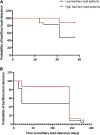Systematic assessment of clinical and bacteriological markers for tuberculosis reveals discordance and inaccuracy of symptom-based diagnosis for treatment response monitoring
- PMID: 36419786
- PMCID: PMC9677322
- DOI: 10.3389/fmed.2022.992451
Systematic assessment of clinical and bacteriological markers for tuberculosis reveals discordance and inaccuracy of symptom-based diagnosis for treatment response monitoring
Abstract
Background: Clinical symptoms are the benchmark of tuberculosis (TB) diagnosis and monitoring of treatment response but are not clear how they relate to TB bacteriology, particularly the novel tuberculosis-molecular bacterial load assay (TB-MBLA).
Methods: Presumptive cases were bacteriologically confirmed for TB and assessed for symptoms and bacteriological resolution using smear microscopy (SM), culture, and TB-MBLA over 6-month treatment course. Kaplan-Meier and Kappa statistics were used to test the relationship between symptoms and bacteriological positivity.
Results: A cohort of 46 bacteriologically confirmed TB cases were analyzed for treatment response over a 6-month treatment course. Pre-treatment symptoms and bacteriological positivity concurred in over 70% of the cases. This agreement was lost in over 50% of cases whose chest pain, night sweat, and loss of appetite had resolved by week 2 of treatment. Cough resolved at a 3.2% rate weekly and was 0.3% slower than the combined bacteriological (average of MGIT and TB-MBLA positivity) resolution rate, 3.5% per week. A decrease in TB-MBLA positivity reflected a fall in bacillary load, 5.7 ± 1.3- at baseline to 0.30 ± 1.0- log10 eCFU/ml at month 6, and closer to cough resolution than other bacteriological measures, accounting for the only one bacteriologically positive case out of seven still coughing at month 6. Low baseline bacillary load patients were more likely to be bacteriologically negative, HR 5.6, p = 0.003 and HR 3.2, p = 0.014 by months 2 and 6 of treatment, respectively.
Conclusion: The probability of clinical symptoms reflecting bacteriological positivity weakens as the patient progresses on anti-TB therapy, making the symptom-based diagnosis a less reliable marker of treatment response.
Keywords: TB symptoms; TB-MBLA; bacteriological tests; diagnosis; monitoring.
Copyright © 2022 Mtafya, Sabi, John, Sichone, Olomi, Gillespie, Ntinginya and Sabiiti.
Conflict of interest statement
Life Arc, which is developing TB-MBLA for clinical use, receives pro bono advice from SG and WS. The remaining authors declare that the research was conducted in the absence of any commercial or financial relationships that could be construed as a potential conflict of interest.
Figures




Similar articles
-
Reduction of blood C-reactive protein concentration complements the resolution of sputum bacillary load in patients on anti-tuberculosis therapy.Front Immunol. 2022 Sep 16;13:1005692. doi: 10.3389/fimmu.2022.1005692. eCollection 2022. Front Immunol. 2022. PMID: 36189292 Free PMC article.
-
High Mycobacterium tuberculosis Bacillary Loads Detected by Tuberculosis Molecular Bacterial Load Assay in Patient Stool: a Potential Alternative for Nonsputum Diagnosis and Treatment Response Monitoring of Tuberculosis.Microbiol Spectr. 2022 Feb 23;10(1):e0210021. doi: 10.1128/spectrum.02100-21. Epub 2022 Jan 12. Microbiol Spectr. 2022. PMID: 35019686 Free PMC article.
-
Performance evaluation of alternative bacteriological measures of response to MDR-TB therapy during the initial 16 weeks of treatment.Res Sq [Preprint]. 2025 Apr 10:rs.3.rs-5834681. doi: 10.21203/rs.3.rs-5834681/v1. Res Sq. 2025. PMID: 40297689 Free PMC article. Preprint.
-
Molecular Bacterial Load Assay Concurs with Culture on NaOH-Induced Loss of Mycobacterium tuberculosis Viability.J Clin Microbiol. 2019 Jun 25;57(7):e01992-18. doi: 10.1128/JCM.01992-18. Print 2019 Jul. J Clin Microbiol. 2019. PMID: 31018981 Free PMC article.
-
Sampling strategy for bacteriological diagnosis of intrathoracic tuberculosis.Respir Med Res. 2021 May;79:100825. doi: 10.1016/j.resmer.2021.100825. Epub 2021 Apr 27. Respir Med Res. 2021. PMID: 33971432 Review.
Cited by
-
Stool-Based Molecular Tuberculosis Treatment Monitoring: A Faster Means for Detecting Persistent Mycobacteria Compared to Phenotypic Culture.Open Forum Infect Dis. 2025 Jun 24;12(8):ofaf345. doi: 10.1093/ofid/ofaf345. eCollection 2025 Aug. Open Forum Infect Dis. 2025. PMID: 40799783 Free PMC article.
-
Triage test for all-oral drug-resistant tuberculosis (DR-TB) regimen: a phase IV study to assess effectiveness, feasibility, acceptability and cost-effectiveness of the Xpert MTB/XDR assay for rapid triage and treatment of DR-TB.BMJ Open. 2024 Nov 27;14(11):e084722. doi: 10.1136/bmjopen-2024-084722. BMJ Open. 2024. PMID: 39609025 Free PMC article.
References
-
- Maclean E, Mckenna L, Ruhwald M. Pipeline Report 2021. New York, NY: Treatment Action Group; (2021).
-
- World Health Organization. Global Tuberculosis Report. Geneva: World Health Organization; (2021).
-
- Tiberi S, du Plessis N, Walzl G, Vjecha MJ, Rao M, Ntoumi F, et al. Tuberculosis: progress and advances in development of new drugs, treatment regimens, and host-directed therapies. Lancet Infect Dis. (2018) 18:e183–98. - PubMed
LinkOut - more resources
Full Text Sources

